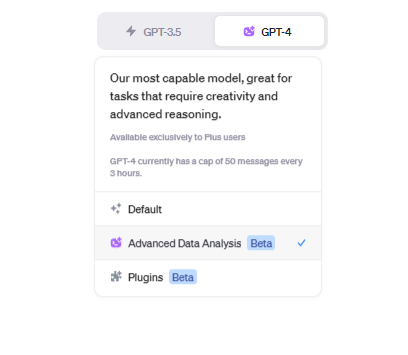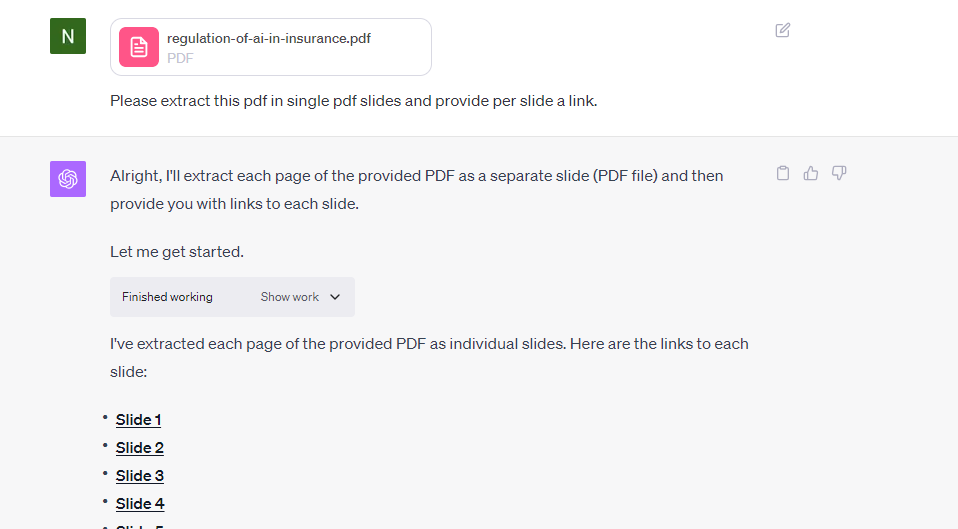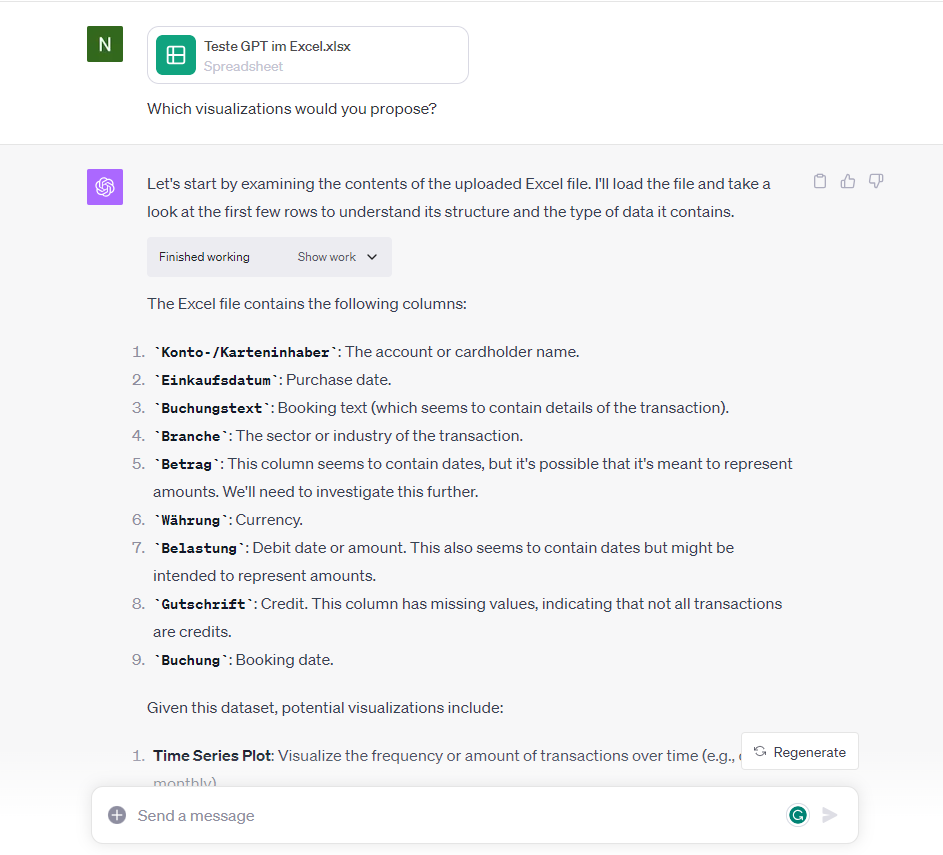How ChatGPT can help you to analyze data fast
In this blog you will learn the slice and dice with Generative AI when it comes to the analysis of your PDFs, excels, CSVs, and more. Learn the first steps on how you can visualize even data with advanced prompt engineering. This article is very useful for analysts, reporting specialists, controllers, and marketers who have to generate reportings and summaries on a regular basis and want to do it more efficiently. Join one of my courses in Zurich to get 1:1 support or send my team a message.
What are important analytics use cases with Generative AI?
Generative AI can be used to detect patterns and provide ideas when it comes to data visualization.
To name some important use cases:
- Ask and summarize pdfs
- Analyze sheets with numbers (Web, Sales, News)
- Extract PDFs, transform them, and query for specific data
- Generate reports (e.g. make your controlling analysis, generate excel charts)
- Generate social media posts
- Generate ideas on how to analyze and visualize data with Generative AI
What is ChatGPT Advanced Data Analysis?
This tool was formerly known as "Code Interpreter". Now, it comes with the brand new name "Advanced Data Analysis" but still many people do not know its power and capabilities. So continue reading ...
Where can I find ChatGPT Advanced Data Analysis?
1) If you cannot see this option, go to "settings" (left corner of the main dashboard) and activate all Beta release options
2) The availability sometimes is depending on the device and operating system you are working on (iOS, Tablets)
3) Contact the OpenAI support in case you cannot see the option.

Source: using Advanced Data Analysis in ChatGPT
Ask and summarize Excels and PDFs with ChatGPT
1) Upload the files that I want to analyze with the "Plus" button below in the entry field.
2) Specify your ChatGPT prompt: "Summarize the PDF". If you do not know what to analyze at all, no problem:
3) Ask ChatGPT for 10 analysis methods or ideas
4) Have the 3 best analysis methods performed
... and voilà 👀👏, some exciting ideas come together.
Have the most important analysis ideas carried out.

How to extract PDFs with ChatGPT from a big PDF
- Upload for example this pdf about AI regulation in the insurance industry.
- Ask the prompt to exract in single PDFs.
- And now you can easily ask ChatGPT so summarize a single page.

How to analyze an Excel and generate graphs with ChatGPT
You can easily upload your excel file (e.g. expenditures) or any web analysis and let ChatGPT think about the possible ways to analyze it:
- Upload your CSV or xls or even JSON
- Ask ChatGPT how you can visualize it: "Which visualizations would you propose. Please create a graph as a PNG to download".
- Then you could upload a PowerPoint template you usually need.
- Ask ChatGPT to add the PNG into your PowerPoint.

What are the limitations of analyzing data with ChatGPT?
- ChatGPT's advanced data analysis cannot directly search the internet. If you attempt to, it will respond with something like: "I'm sorry, but I cannot directly browse the web or access external websites like Bing." To access the browsing feature, you must select it when initiating a "new chat". This means that if you wish to analyze data, you'll need to manually copy and paste the information from the co-browsing service to the advanced data analysis service. Admittedly, this can be a bit cumbersome.
- Remember, it's essential to avoid uploading confidential or personally identifiable information to ChatGPT Plus (find a simple guide about
ChatGPT and policy and privacy).
If you don't want OpenAI to potentially use this data for training their models or are uncertain about the implications, exercise caution. Tools exist that can extract personally identifiable information, such as organization names, using machine learning techniques like NER.
- Overall, you can discover patterns in data without being a data scientist or data mining specialist
🔍. However, there's a caveat: ChatGPT's Advanced Data Analysis doesn't always function perfectly. The quality of the analysis is directly related to the cleanliness of the data. It's crucial to critically evaluate the results from large language models like GPT. Those familiar with basic analysis methodology or data mining are better equipped to discern inaccurate responses from the model. If you're ever unsure, feel free to ask ChatGPT for clarity. Also, if you encounter issues with specific data formats, consider converting them (e.g., from csv to xls, or to json). You can even utilize ChatGPT to assist in cleaning your data.
With the ChatGPT Advanced Data Analyzer, you can create graphs, tables, ppts and more. It does not always work at first trial but give it a try😉.
Need support with your Generative AI Strategy and Implementation?
🚀 AI Strategy, business and tech support
🚀 ChatGPT, Generative AI & Conversational AI (Chatbot)
🚀 Support with AI product development
🚀 AI Tools and Automation















